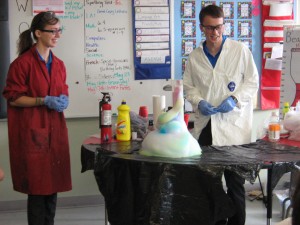Hello!
Today we were fortunate enough to have the Discover E team from the University of Alberta’s Faculty of Engineering come and visit us. They came to do a Chemistry demonstration. This demonstration taught students the difference between a chemical and a physical change. Once we understood that a chemical reaction is a non reversible change that might result in: a gas being produced, a light being produced, a change in temperature, a change in colour, etc. we were able to witness some pretty cool chemical changes. The first experiment involved mixing some hydrogen peroxide, soup, food colouring, and water. This is experiment help us to learn what a catalyst is (something to speed up a chemical reaction). When the catalyst was added a colourful foam was produced. This foam caused an increase in the temperature, demonstrating a chemical change. We could even see steam! Our next experiment involved lighting a $20 bill on fire. The demonstrators covered the bill in isopropyl alcohol and water. They then lit the bill on fire. Since alcohol burns at a lower temperature than water boils, the alcohol is burned off before the bill becomes hot enough to have the water evaporate and the bill catch on fire. Finally, they lit a combustible powder on fire. In order to do this, they had to find a way for the powder to have as much oxygen as possible (because we need oxygen for something to burn). They put the powder in a can with some candles, put the lid on it, and then through a tube blew the powder to spread it out. The powder caught fire, blowing the lid off the can. It was pretty amazing. Check out some of our pictures below. Thanks to our presenters for their hard work today.
The Gr. 4 students started Geometry today. They began by examining shapes such as rectangular prisms, triangular prisms, cones, pyramids, etc. and comparing them to objects that we see in life. We also discussed the attributes of these objects, such as their bases and faces.
In Social Studies we discussed the Eastern Woodland Hunters (Algonquin) and the Eastern Woodland Farmers (Iroquoian). We discussed some of the culture differences between the groups (ex. food resources), and how this impacts day to day life. We were particularly interested to learn about the importance of the three sisters (corn, beans, squash), and that the Iroquoian groups had a complex democratic system. These groups would meet to in local, tribal, and confederate groups as needed, and reached decisions through consensus, often meeting well into the night.
In Language Arts today we discussed rhythm. As mentioned in a previous blog, we will be returning to poetry to continue discussing poetic devices, off and on until the end of the year. Today we discussed rhythm in poetry and syllables. Students were then challenged to try and discover the rhythm of “The Walrus and the Carpenter” by Lewis Carroll. It was difficult at first, but once the poem is written out, many of us were able to use the syllables to help figure out the pattern (8 syllables, 6 syllables, 8 syllables, 6 syllables, etc.). We are going to be using our new knowledge next week to write some Haikus.
Homework: Read 20 minutes
Multiplication Quiz – Friday
Spelling Quiz – Friday
Reading Journal – Friday
Math: Gr. 4 – pgs. 224-225
Book Orders – May 23rd
Intent Forms – May 17th


